
SRI VENKATESA SUPRABHATAM (With Sanskrit Text, Transliteration and English Translation)
Book Specification
| Item Code: | IDG254 |
| Author: | T. Venkatacharya |
| Publisher: | The Adyar Library and Research Centre |
| Language: | With Sanskrit Text, Transliteration and English Translation |
| Edition: | 1999 |
| ISBN: | 8185141282 |
| Pages: | 110 |
| Cover: | Hardcover |
| Other Details | 8.5"X5.5" |
Book Description
About the Author:
T. VENKATACHARYA, Emeritus Professor of Toronto University, is a well-known traditional Sanskrit scholar, and an authority on grammar and literature, as well as Visistadvaita. Among his other publications in the Adyar Library Series are:
Rasarnavasudhakara of Simhabhupala (ALS 110), an authoritative work on Indian aesthetics.
Udararaghava of Sakalya Malla (ALS 118), a Mahakavya with three commentaries dealing with the story of the Ramayana.
Sriharicarita Mahakavya of Srihari Padmanabha Sastrin (ALS 102) on the story of Sri Rama.
Dasarupaka of Dhanamjaya (ALS 97, out of print).
Preface:
An exposition in English is presented in the following pages of the work that is popularly known as Sri Venkatesa Suprabhatam. The work contains four segments, of which the first in the Suprabhatam and then come the Stotram, Prapatti and Mangalasasanam. The entire composition is recited every day early in the morning, in front of Sri Venkatesvara, who is commonly known among the people, particularly of South India, as the Lord of the Seven Hills. The great temple of Sri Venkatesvara is situated on the regional languages of Telugu and Tamil as Tirumala and Tirumalai ( and sometimes as Tirupati though this is a town located lower at the foot of the hills-adivaram). In some other parts of India he is also referred to as Balaji (Venkatesvara). I do not know the reason for or the significance of this reference.
What is presented here is not a literal translation, but it contains, apart from the meanings of the verses, on occasions some brief discussions touching on the points of the Visistadvaita of Sri Ramanujacarya. It also has some cross-references, and information about the author, his date and the times to which the composition belonged. My friend Sri Bala Madhava very kindly helped me with the laborious task of taking down the dictation, verifying the sources, typing and retyping (several times) both Sanskrit and English portions with a view to having the entire material as free from mistakes as possible. Without this abundant and unstinting assistance in ways more than one, from him and his wife, Srimati Sarojini Bala Madhava, this humble work would not have seen the light of day. Sri Bala Madhava belongs, by profession, to the field of engineering. Yet, he has a good knowledge of Sanskrit and has a deep interest in our culture, customs, traditions, literature, religion and philosophy. For all the hard work done, my gratitude to him and to his wife cannot be conveyed sufficiently in words, but I am indeed very grateful to both of them.
I have great pleasure in writing a Foreword to this useful and authentic edition of Sri Venkatesa Suprabhatam, one of the earliest and most popular Stotra-s of the Suprabhata genre on Sri Venkatesa, the deity of the ancient Visnu temple at Tirumalai. The author Prativadi Bhayamkara Acarya alias Annan of Kancheepuram who flourished from A.D. 1361 to 1454 is said to have been a direct disciple of the son of Sri Vedanta Desika,
The text is given in Devanagari and Roman transliteration with English translation and expository notes by Professor T. Venkatacharya of Toronto University. He is a specialist in Sanskrit grammar and literary criticism, Visistadvaita and classical Sanskrit literature. The Adyar Library and Research Centre have already published some standard works edited by Professor T. Venkatacharya.
Along with the Sri Venkatesa Suprabhatam, three other works of the same author - Stotram, Prapatti, and Mangalasasanam have also been included in this edition. In front of the sanctum complex of Sri Venkatesvara temple at Tirumalai are two tall images of Dvarapalaka-s Jaya and Vijaya. The door, which is covered by resplendent gold plate, displays small figures of Visnu in different forms. The Venkatesa Suprabhatam is daily recited in the morning in front of this golden door in which Visnu is depicted in five forms: Para, Vyuha, Vibhava, Antaryami and Area.
The Suprabhatam starts with a famous verse from Viilmiki Ramayana, Sage Visvamitra wakes up Sri Rama, reminding him that it is time for him to perform his daily duties.
'Dear Rama, Kausalya is blessed in having you as her son. The dawn has appeared in the east. Rise Oh ! valiant man. You have to perform your daily rituals.' After Visvamitra had started from Ayodhya with Rama and Laksmana, the sage wakes them up on the first morning of the journey.
This verse has given the. inspiration to our poet to write his Venkatesa Suprabhatam, but the situation is slightly different. Lord Venkatesa is Lord Narayana himself. He does not sleep like human beings, even while apparently asleep. He is ever vigilant. His sleep is a kind of yoga- nidra. There is no need to wake him up. But Rama and Laksmana were young boys going to the hermitage of V isvamitra to help him.
Ramanuja and his followers who were Sri Vaisnava-s stressed the importance of Laksmi residing in the breast of Lord Venkatesvara. This idea is repeated in many of the verses of the Suprabhatam. The presiding deity of Tirumala temple, Srmivasa, stands majestically with Laksmi on the right side of his chest: laksminivasa, kamalakucacacuka- kunkumato ... , srinivasaya mangalam etc. According to Sri Vaisnava-s Sri or Laksmi is given a prominent place as the mediatrix who pleads to the Lord to shower his grace on his devotees. She is the embodiment of compassion. Many of the verses in the Suprabhatam show the reverence and affection with which she is held by the devotees. 'Mother of all the worlds who dwells on the chest of Visnu, Oh! mother of matchless divine beauty, bestower of the wishes of the devotees, consort of Lord Venkatesa, suprabhatam to you !'
Some of the verses of the Suprabhatam give picturesque descriptions of the many divinities and devotees thronging the precincts of the temple to have darsana of the Lord in the morning. 'The seven sages beginning with Atri are waiting with lotus flowers to worship thy feet.' Lord Siva, Sanmukha and Brahma and other divine beings chant thy names, while Brhaspati, the preceptor of the gods is reading the almanac (pancanga) for thee.' 'Swarms of bees spending the whole night inside the lotus buds and intoxicated with honey drunk therein have come out to worship thee, humming notes of music praising thee.' 'Garuda, Simha, Adisesa, Airavata and Uccaihsravas, are there vying •with one another to worship thee.•' 'The nine planets like the sun and the moon are standing with humility before thee !' 'People who see at least once the seven spires of your Gopura are blessed with permission to enter heaven, but they do not like to go there since they want thy company here on earth.'
The computer setting of the press matter containing Devanagari, with Roman transliteration, has been done by Miss T.M. Ramani on the newly set-up machinery in the Adyar Library under the general direction of Mr. S. Venkatesh.
Professor Charles S.J. White of the U.S.A. has gone through the English matter and polished the language.
Mrs. Radha Burnier and Dr. K. Kunjunni Raja have made necessary editorial changes in conformity with the Adyar Library style. Professor S. Sankaranarayanan and Professor R. Thangaswami Sarma were consulted when any problem arose.
TUPPIL VENKATACHARYA
| Page | ||
| FOREWORD | ix | |
| PREFACE | xiii | |
| ACKNOWLEDGEMENTS | xv | |
| INTRODUCTION | 1 | |
| I. | SRI VENKATESA SUPRABHATAM | 9 |
| II. | SRI VENKATESA STOTRAM | 31 |
| INTRODUCTION TO SRI VENKATESA PRAPATTI | 41 | |
| III. | SRI VENKATESA PRAPATTI | 43 |
| INTRODUCTION TO SRI VENKATESA MANGALASASANAM | 65 | |
| IV. | SRI VENKATESA MANGALASASANAM | 71 |
| APPENDIX | 81 | |
| BIBLIOGRAPHY | 89 | |
| INDEX OF VERSES | 91 |
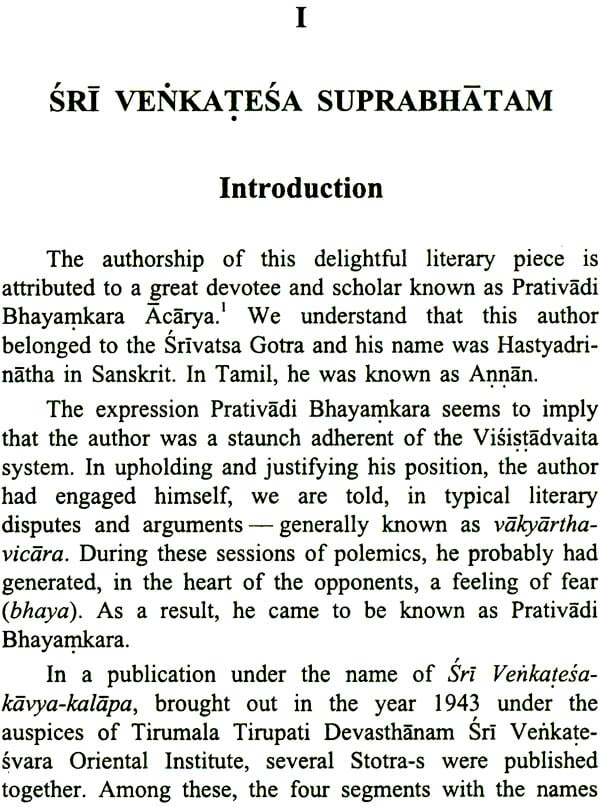
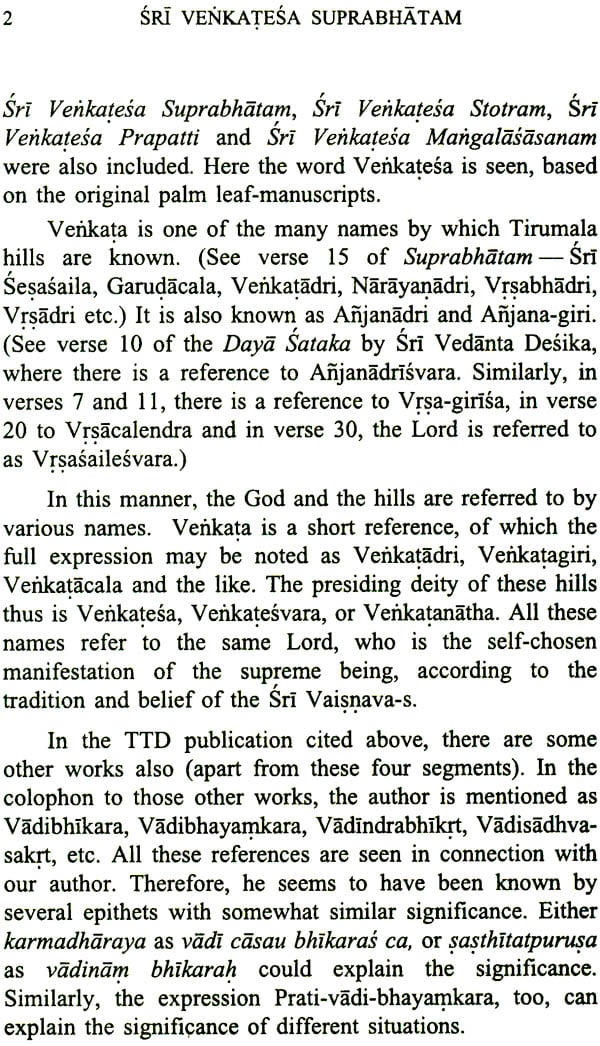
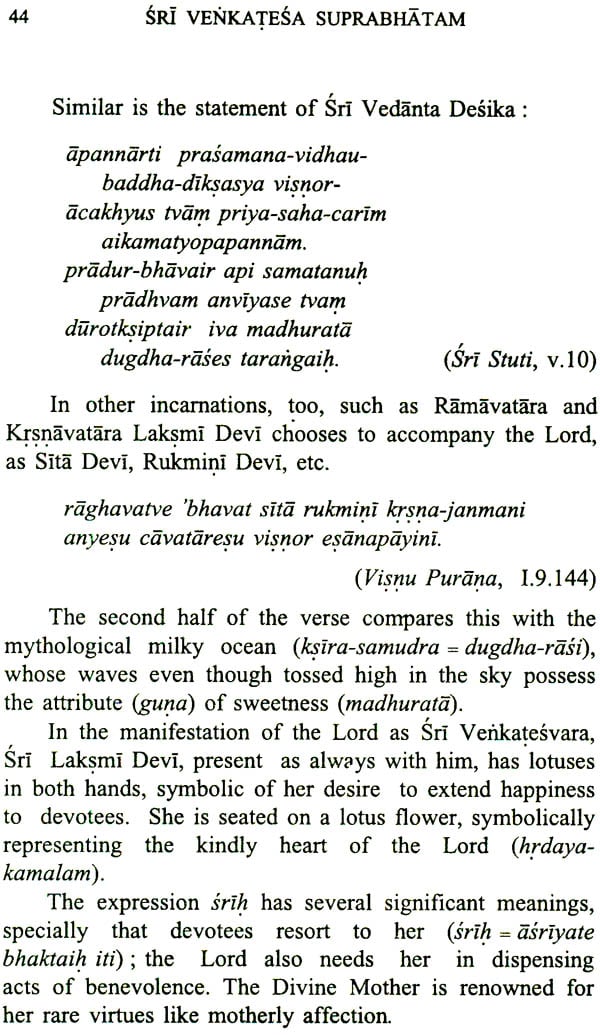
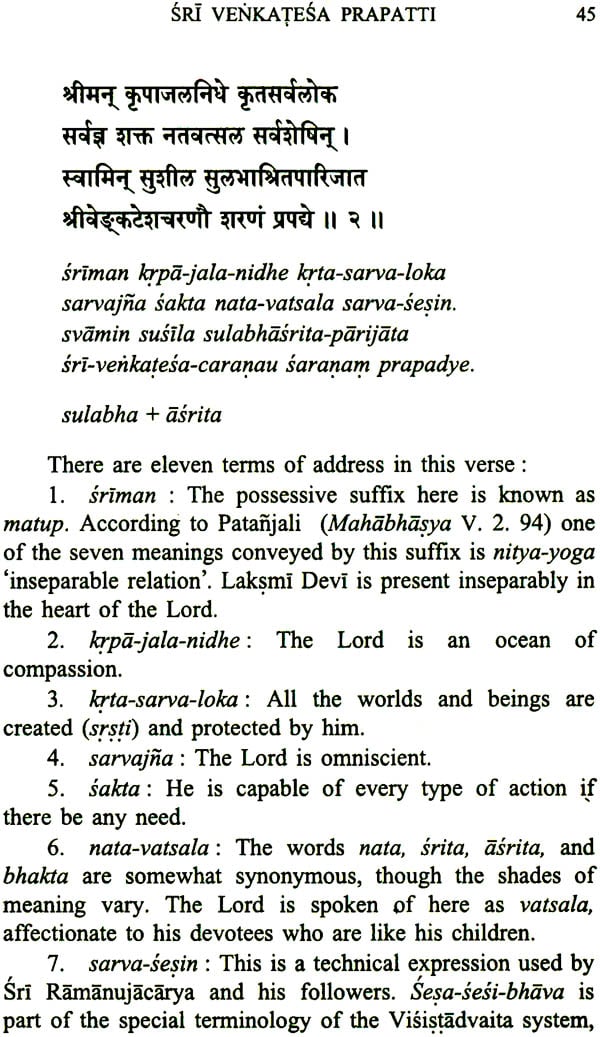
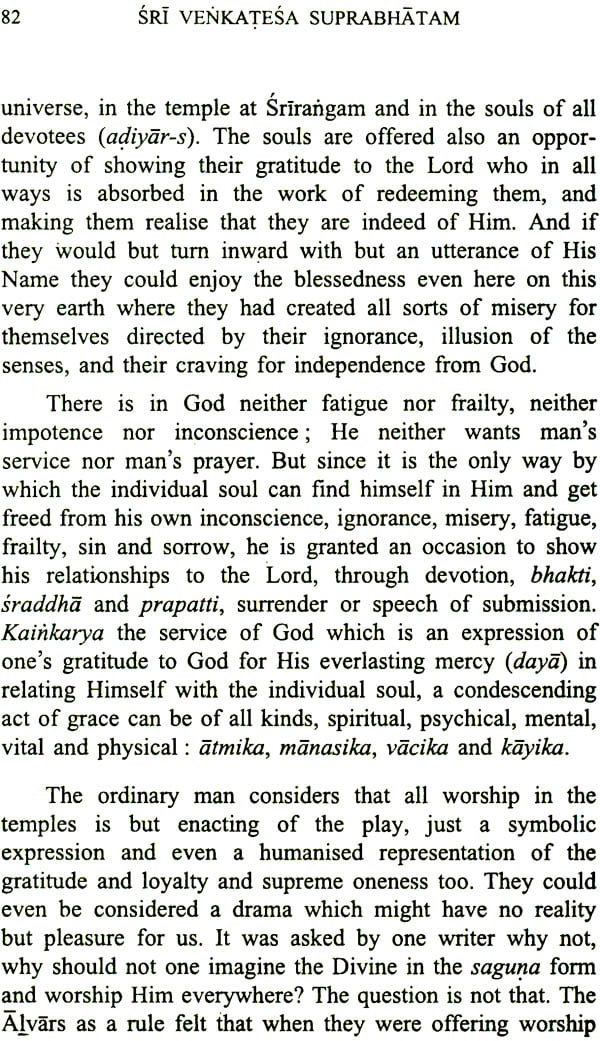
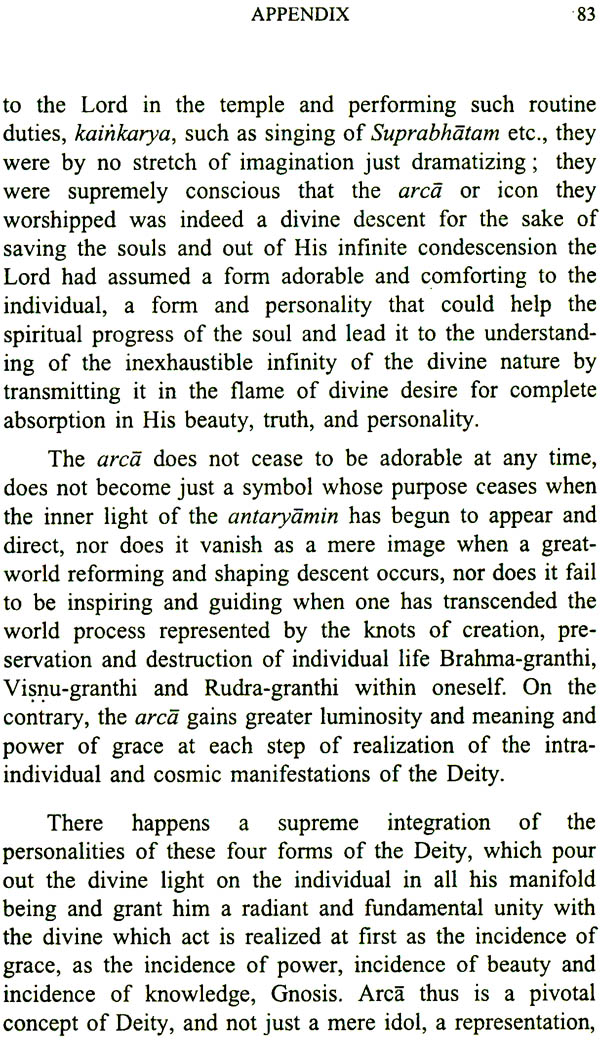
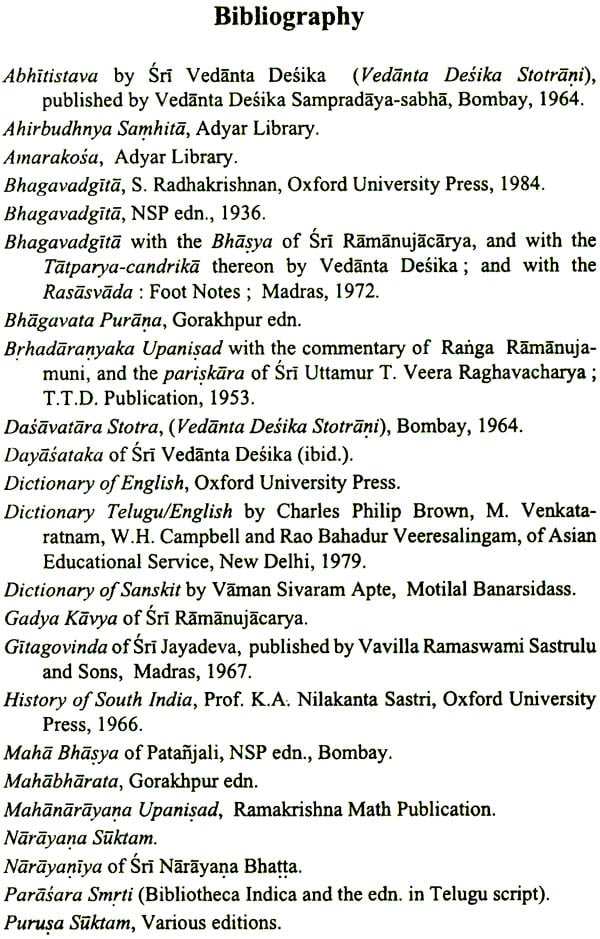
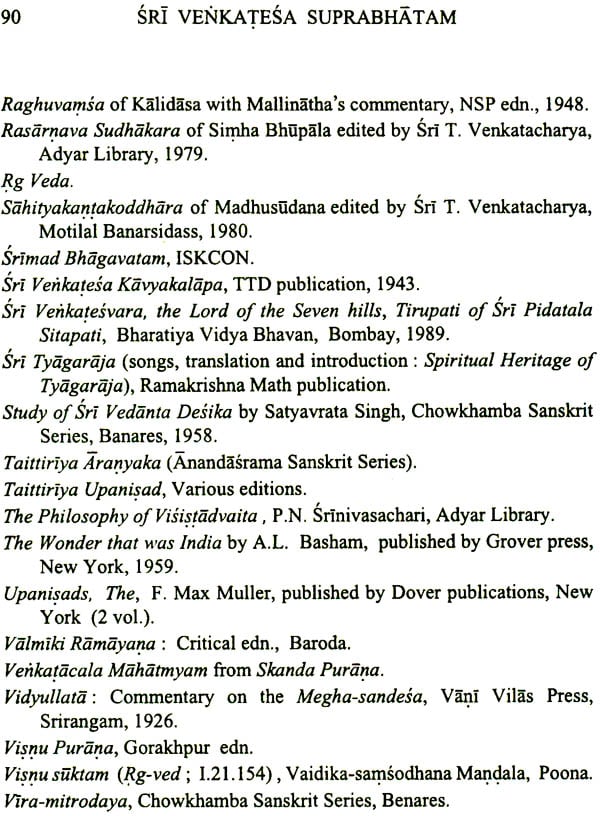
Click Here for More Books Published By Adyar Library and Research Centre





